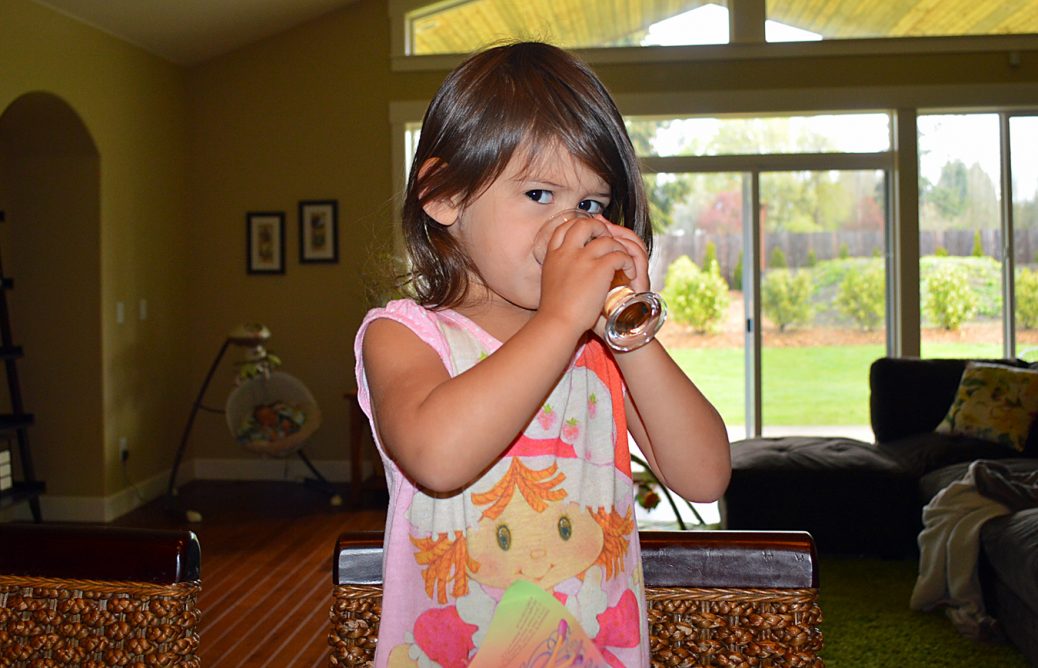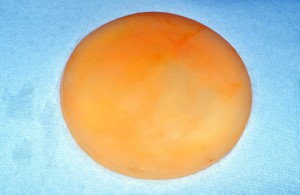
The scoby contains beneficial bacteria and yeast
According to the American Cancer Society, “Kombucha tea has been promoted as a cure-all for a wide range of conditions including baldness, insomnia, intestinal disorders, arthritis, chronic fatigue syndrome, multiple sclerosis, AIDS, and cancer. Supporters say that kombucha tea can boost the immune system and reverse the aging process.” However, I will caution you that there is little scientific evidence to support such strong claims.
For my family, kombucha is simply fun to make, with the added benefit that it is highly recommended among many of my holistic friends. It’s a wonderful probiotic. It is naturally fermented with a living colony of bacteria and yeast, which is helpful for digestive health. I think it smells a little strong, but it’s actually pleasant-tasting.
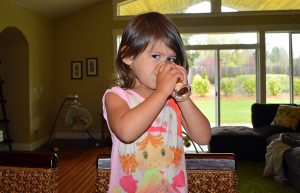
My kids love drinking kombucha.
Making kombucha tea
Using a gallon jar, combine 14 cups of hot water and 1 cup sugar in the glass jar you intend on using to brew the tea. Stir until the sugar dissolves. The water should be hot enough to steep the tea, but does not have to be boiling.
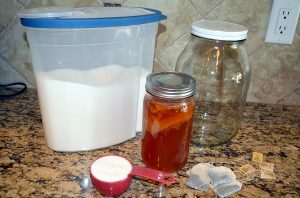
Making kombucha only requires water, tea, juice, sugar, and a scoby.
Place the tea or tea bags in the sugar water to steep. Use 8 tea bags for a gallon of tea. I prefer the flavor of green tea, but you can also use black tea. Try to find an organic tea. If you use loose tea leaves, use 4 Tbsp. for a gallon of tea.
Cool the mixture to room temperature. The tea may be left in the liquid as it cools. Once cooled, remove the tea bags or completely strain the loose tea leaves from the liquid. Add starter tea from a previous batch to the liquid. If you do not have starter tea, substitute with distilled white vinegar — 2 cups for a gallon of tea.
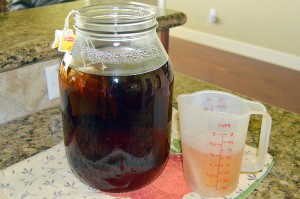
Let the tea steep until the mixture is at room temperature. Then add the vinegar or starter tea.
Add an active kombucha scoby (you can purchase online or get one from a kombucha-making friend). Cover the jar with a towel or coffee filter and secure with a rubber band; ants can smell sweet tea a mile away. Allow the mixture to sit undisturbed at 68-85°F, out of direct sunlight, for 7-30 days, or to taste. The longer the kombucha ferments, the less sweet and more vinegary it will taste. When making it for children, you may consider only letting it ferment for the 7-day period.
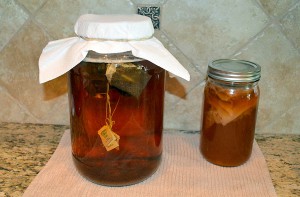
After adding the scoby, cover the jar with a towel or coffee filter to protect against insects.
Keep the scoby and about 1 cup of the liquid from the bottom of the jar to use as starter tea for the next batch. You will have the “mother scoby” that you added and a new “baby scoby” that will have formed on the top. You can reuse your mother scoby, and gift your baby to a friend by placing it and about 1-2 cups of the finished kombucha in a Mason jar.
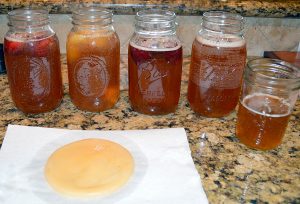
Give the baby scoby to a friend!
The finished kombucha can be flavored, or enjoyed plain. Keep sealed with an airtight lid if you like a fizzy drink like soda. My kids prefer fruit-flavored kombucha, and this can be done by adding any fruit juice to the cultured tea. Add 3 Tbsp. of fruit juice per quart, seal with an airtight lid, and allow to culture on the counter for about 14 days. It can then be stored in the refrigerator. You can use quart Mason jars to try multiple flavors or make single servings.
Another way to flavor the finished kombucha is by adding lemon and ginger. Add ½ tsp. sugar, 1 Tbsp. fresh chopped ginger, fresh juice from ½ a lemon to a quart Mason jar. Fill the rest of the jar with brewed kombucha, and allow to culture on the counter for 5-7 days. Strain out the ginger pieces, and store in the fridge.
You can also add just lemon to lessen the smell and flavor of vinegar. To make a simple lemon kombucha, add 1 Tbsp. to every pint of finished kombucha tea, let ferment on the counter for abut 12 hours, then refrigerate. My kids like when I add lemon and fresh or frozen berries. I allow the berries to ferment in the tea for 12 hours, strain the fruit using a cheesecloth, and then refrigerate. They say it tastes like fizzy fruit tea.
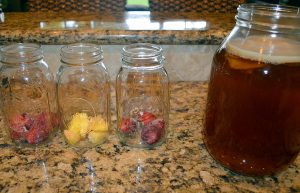
Add frozen fruit to make a fun treat.
There is really no end to the flavors you can create for your kombucha, so have fun with it. These little bottles of “hippie tea” have been popping up all over grocery stores for about $3 a bottle, but you can make it at home for around $1 a gallon. Whether or not it cures cancer, I am not sure, but at worst you have a delightful and affordable probiotic.

